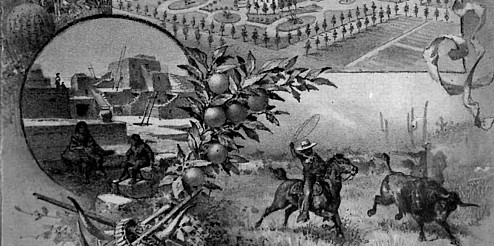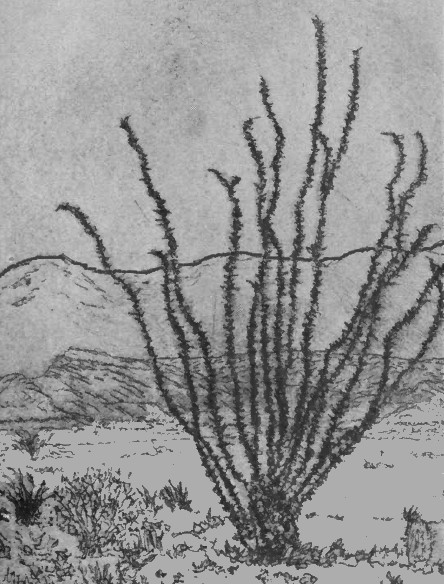Following the line of least resistance, much prospecting was done in the late '50s northward from Yuma along the Colorado. Placers were worked only fifteen miles above the Gila at the Potholes, about where the present Laguna dam has been placed. The old town of La Paz owed its existence to placer mining in the gulches to the eastward. Forty miles above Fort Yuma, in 1858, a prospector named Halstead discovered the Colorado River copper mine, claimed the copper ore was very rich, though it failed to stand the test of time. Several tons of ore were shipped to San Francisco, and the property was bought from Halstead by Wilcox, Johnson & Hartshorn, who owned a steamer plying on the Colorado, and with whom were associated Hooper, a Fort Yuma merchant, and Lieutenant Mowry.
Twelve miles east of the Colorado and a short distance from Bill Williams Fork lies the Planet, one of the oldest copper mines of Arizona and one that still shows signs of activity. It was worked as early as 1863 by a San Francisco company, which for a while operated two small furnaces on oxide and carbonate ores and which proposed shipment of ore by sailing vessels from the Colorado's mouth to Swansea, at a cost estimated at $25 a ton, for ore that averaged $300 a ton. Heavy ore shipments were made to San Francisco. The Springfield company also operated a copper furnace about the same time on ore from the Orion mine.
In 1856 Lieutenant Humphries reported he had found gold, silver, copper and lead in the country east of the Colorado on the northern road. Judge Jas. M. Sanford, with John Brown of San Bernardino, built the first ferry at the Mojave crossing of the Colorado in 1861, and in the fall of the following year left the river with twelve men to hunt for gold diggings heard of to the westward. Only four of the expedition are said to have returned. Sanford spent his last days at Williams. The Mojave Mountains again were explored in the summer of 1863 by a party headed by Chas. "W. Strong, representing New York capital. The same region was visited and discussed scientifically the following summer by B. Silliman.
The San Francisco District of Mojave County is one of the oldest in Northern Arizona and early in the '60s small mills had been erected at Hardyville for handling gold ores. Early established was the "Wauba-Yuma mining district, twenty miles east of Hardyville. The name given was that of an Indian chief. Howard Coit, later for years caller of the San Francisco Stock Exchange, was recorder of Wauba-Yuma District and owned one of the very few claims that have endured.
EARLY-DAY MOJAVE MINING DISTRICTS
The miners of Northwestern Arizona in the early sixties were soldiers from
Camp Mojave, off on brief furlough,
or discharged soldiers of the California Column. That they were men of
education and of mining experience is shown by the records they kept, still
available, stored in the neat recorder's office at Kingman. The official
pioneer records at Kingman probably are the best preserved in all the state.
As early as January 1, 1863, there had been a meeting of miners of Colorado
district, held in the San Juan Company's office at El Dorado Canon. The
district was organized at a meeting January 8. William Caley was elected
president and reference made to the election of a Mr. Lewis as recorder, to
fill an unexpired term that began June 1, 1862, showing prior action along
the same line. There had been 661 locations in this district by the end of
1863. On November 13, 1863, there was a meeting of miners at Soldiers'
Springs, whereat George Okey was elected chairman and John Comerford,
secretary, and there was formed San Francisco Mining District, running
twenty-five miles along the Colorado and fifty miles to the eastward. Each
locator was granted a claim 200 feet long and 150 feet on each side of the
lode. It was ordered that the books of the district be kept at Fort Mojave or at Silver Creek, "the
position of the district being in an Indian country and away from
protection." Robt. A. Rose was elected the first recorder. On the last day
of the same year, Rose was succeeded by W. Walter. Within the district the
first claim record was the Nevada Lode, November 23, 1863, the locators John
Comerford, George Okey, W. S. Pearson and Robt. A. Rose. A number of
locations were made along this same Nevada lode formation, by the Union,
Lincoln, Todd, Hancock, Stanley and other companies, some of the appended
names being R. C. Drum, DeWitt Titus, D. J. Williamson, John Stark, W. E.
Strong, J. I. Fitch, R. P. Nason, Charles Atchison, John Murray, D. W.
Ridley. Sixty claims had been placed at the site and recorded there by the
close of the year. The first deed was from W. B. Jeffries to M. G. Moore and
A. E. Davis, both parties resident at Fort Mojave, conveying for the sum of
-$95 the Union original location.
Now included within the Oatman District is the old Moss mine, located by John Moss in 1863 and now under bond to the United States Smelting and Refining Company. The surface ores were very rich. Two tons taken out in 1865 returned the owners .$185,000. In latter days golden riches have been uncovered in the Tom Reed and Gold Roads mines. The croppings of the latter in the River Range Pass were crossed by the main road that ran westward to Fort Mojave and Hardyville, but it was not till years afterward that the mine was located by Jose Jerez, a Mexican prospector, "grub-staked" by Henry Lovin of Kingman. They sold for $50,000, but the mine thereafter has produced annually not less than ten times its cost.
Some time before 1874 there were two small smelting furnaces at Chloride, in that year one of them already being reported in ruins. Lode mining at Chloride Flat was started as early as 1864 on claims at Silver Hill, but it is told that the first miners, three in number, were killed by Haulpais, one murdered at the windlass and the two others stoned to death in the shaft. Other
miners in the same locality were killed or driven off and for a few years mining in Mohave County was considered a rather uuhealthful occupation. One of the smelters at Chloride was the Baker furnace, placed close to the Schuylkill claims. The mines around Cerbat were worked as early as 1863, at date that gave the name to the Sixty-three mine, two miles northwest of the camp. In 1857 the first effective quartz stamp mill in the county was built by Davis & Randall, near Hackberry, on a mine that had been discovered in October, 1874, by William Ridenour, S. Crozier and two others. They had been prospecting in the Grand Caiion and, after attack by the Indians and losing all but their lives, managed to reach Mineral Park, thereafter to discover the Hackberry claim, one of the richest of the early mines. Another little mill was started at Mineral Park on Washington's Birthday in 1876,
In Southern Mohave County the McCracken mines, six miles north of Bill Williams Fork, was discovered by Jackson McCracken, August 17, 1874, The product of the mine for a while ran as high as $200,000 a month, mainly from a stringer of high-grade lead carbonate, found within a vein over eighty feet in width. The silver ore at first treated averaged about $75 a ton in silver and 20 per cent lead, but the lead percentage increased and the silver decreased, till, about 1881, operations at the camp were practically at a standstill and the nearby mill town of Signal had passed the period of its brief glory. By 1880 Mohave County had become a large producer of silver, from a score of camps, and had secured rank as one of the richest mining sections of the Southwest. A few years later, though favored by railroad construction, there came a time of stagnation that lasted till only a few years ago. Now silver is in the background and native gold and zinc give much larger returns. Chloride and Oatman have assumed large prominence in the mining world.
During the following years at the Oatman camp, within which are included some of the oldest Northern Arizona mines, has been having a boom that seems to approximate that known by Tombstone or the later Nevada camps. Thousands have come to join in expected riches from gold that already has been found at the depth of about 300 feet, in greenish and unattractive quartz that lies beside great diorite dykes that thrust their heads through the country for miles. Great deposits of high-grade ore have been cut in several mines. While the gold is very fine and light, it is cheaply and thoroughly extracted by means of cyanide. Near Mineral Park are turquoise deposits from which since 1904 valuable shipments of the attractive blue gem material have been made to New York. About a dozen mines have been worked, the greatest production from one owned by the Tiffanys. Some of the gem rock is of deep blue color and has value up to $6 a carat. The deposits were worked by the ancient peoples of Arizona, whose stone cutting tools are found scattered around the locality.
Return
to The Arizona Page:
Arizona Gold Rush Mining History



